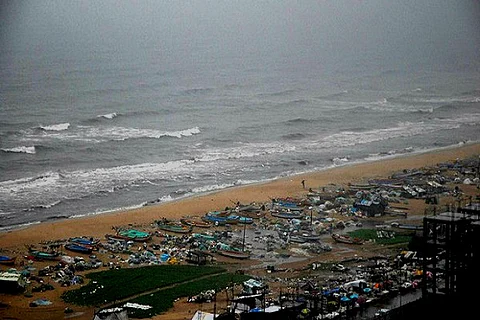

For the past several days, many tenements of a prominent fishing locality located along the beachfront at Pattinapakkam near Mylapore, have suffered damage due to the entry of seawater. This is not the first time that the fishermen are facing this problem as a similar occurrence happened eight years ago.
The area, prone to sea erosion, has been hit by high waves for the past ten days and the seawater has inundated houses, affecting normal life.
“You cannot have a linear cause and effect of the issue. Urbanisation does have an impact because beach beautifications, harbor constructions will always infringe on the coast. The impact is felt far beyond simply those areas," says a coastal sensitivity expert who has worked closely in Cuddalore and Pattinapakkam areas. (anonymity was requested)
In terrestrial systems, if one looks at constructing on a patch of land, the environmental impact would be limited within a radius of 500 m. But when it comes to marine and coastal areas, it can be felt as far away as 10 kms. “If the waves are lashing at another coastal area, the impact may also be felt in Pattinapakkam. What gets washed out in one habitat, is deposited in another, right? Here, there isn't enough sediment to go round,” she says.
Fisheries Minister D Jayakumar, who inspected the area on the orders of Chief Minister Jayalalithaa, said a study would be carried out on sea erosion in the area. He said appropriate action like placing groynes should be considered to prevent a recurrence. A groyne is a low wall or sturdy timber barrier built out from a beach into the sea, to check erosion and drifting.
But coastal experts are not for it. “We need to understand the topography of Pattinapakkam and not just commission groynes. Groynes are for sedate seas, not for high intensity wave areas like these. To stop high intensity waves from impacting normal life, natural bodies like dunes, estuaries, backwaters help in coastal areas. Groynes were meant to replace mangroves, but considering the level of erosion thanks to urbanization, looks like it’s not a solution we can turn to anymore,” the CRA expert said.
The South Indian Fishermen Welfare Association President K Bharathi said putting up groynes may not be the solution and added, "Residents should consider taking up alternative tenements and the government should provide them."
Several fishermen like Kumaran, however, are apprehensive about relocating as it may affect their livelihood. "We depend on sea for our livelihood. Moving out of the seafront may not be an option," he said.
The fishing community somewhere is at fault. In particularly high tide areas like Cuddalore and Pattinapakkam, fishermen know there is an impact from the sea, which is why they build huts and tenements far closer to the coast than allowed by the coastal regulation zone. "It is next to an estuary so there are high sensitivity waves. If anyone, it’s the fishermen who can predict the accuracy of high tides," she said.
According to R Sannasiraj, a professor of IIT Madras' Ocean Engineering department, "The level with which this seawater erosion has occurred last happened eight years ago. But it looks like it might happen with more frequency in the coming years."
The professor added that eight years ago, many lost their homes in an erosion similar to the one this year, but "the government did nothing".
"This is not particularly a normal phenomenon either. The long wave problem is common during the southwest monsoon, but this has made its way from the east coast of Nagapattinam to the West Bengal coast. If we touch this extremely sensitive coast, Marina is likely to be affected and the Adyar river mouth will suffer. Artificial nourishment in sediment is required, but here's the real problem - flooding."